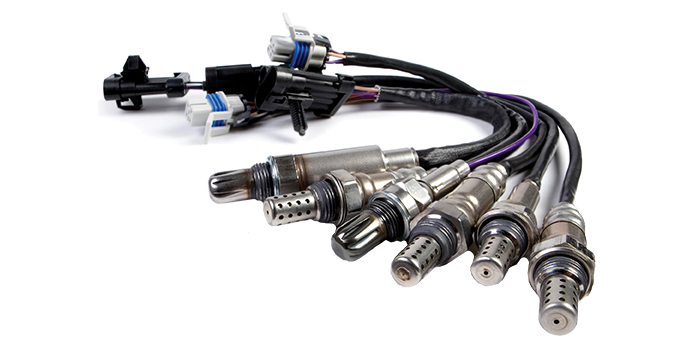An oxygen sensor (or lambda sensors) are electronic devices that help modern automobiles adjust the air-fuel ratio. They are there to measure the oxygen levels in your exhaust gases. This is then transmitted to the engine control unit (ECU) of the car for making modifications in air-fuel ratio.
Oxygen sensors are relatively simple in terms of what they do. Its components include a zirconia metal oxide solid electrolyte (melt-cast into a flat, surface-nuclear shaped element) and sintered with porous platinum film electrode coatings on both faces. This is exposed on one side to the exhaust gases and on the other ambient air. A tiny electrical voltage is generated between the two sides, due to this difference in oxygen concentration. The magnitude of this output pump current depends on elemental contents present with the exhaust stream.
The ECU continuously that monitors the voltage output from oxygen sensor and then uses this signal to regulate fuel injector. If the O2 sensor reports a lean mixture (too much oxygen), then that information is passed to the ECU, which increases combustion and releases additional fuel from the injectors so as to reset this magic 14.7:1 air/fuel numberRACT))))00 ultimately how most engines operate at normal cruising speeds in light loads.
On the other hand, if there is too much fuel in the mixture and not enough oxygen (a rich condition), then the ECU will cut back on how much more than baseline it sends for a couple cycles to keep everything at that optimal stoichiometric surface. This level of control is key to maintaining optimum combustion and reducing the creation of noxious waste gases.
the optimal air-fuel ratio. This precise control over the air-fuel mixture is crucial for ensuring efficient combustion and minimizing the formation of harmful emissions.
Importance of oxygen sensors in reducing emissions
The primary importance of oxygen sensors in reducing automobile emissions lies in their ability to maintain the optimal air-fuel ratio. By continuously adjusting the fuel delivery based on the oxygen content in the exhaust, these sensors help ensure that the engine is running at its most efficient and cleanest state.
Without oxygen sensors, engines would be unable to precisely control the air-fuel mixture, leading to incomplete combustion and the situstoto release of various pollutants into the atmosphere. These pollutants include carbon monoxide (CO), unburnt hydrocarbons (HC), and nitrogen oxides (NOx), all of which are harmful to the environment and human health.
By keeping the air-fuel ratio within the optimal range, oxygen sensors play a crucial role in reducing the formation of these harmful emissions. This, in turn, helps automobile manufacturers meet increasingly stringent emission standards set by regulatory bodies such as the Environmental Protection Agency (EPA) and the European Union (EU).

Impact of oxygen sensors on fuel efficiency
Oxygen sensors play a very important role in reducing emissions and their influence is also seen on the fuel efficiency of automobiles. They keep a close watch on your car’s responsiveness and ensures that the engine is not only running but operating at its best performance by sustaining an optimal air-fuel ratio thus saving you more fuel.
A rich condition (too much fuel) in the air-fuel mixture will cause the engine to use more gas than it needs, resulting in lower mileage. An engine that runs on a lean mixture (too much air) can work the other way round will lose some of its power and fuel economy.
This is where the oxygen sensors come into play, constantly making sure that a perfect mix of air and fuel passes through by adjusting how much fuel is delivered based on the amount of oxygen present in exhaust. The engine then operates at near-ideal efficiency provided by a ratio of around 1:30 for fuel and air which is obviously good in reducing emissions, but also great in getting the most out of each tank.
Common signs of a faulty oxygen sensor
Like any other electronic component in a vehicle, oxygen sensors can eventually wear out or become faulty over time. When this happens, it can lead to a variety of issues that can impact both the vehicle’s emissions and fuel efficiency. Some of the common signs of a malfunctioning oxygen sensor include:
- Check Engine Light: One of the most obvious signs of a faulty oxygen sensor is the illumination of the Check Engine Light on the dashboard. The ECU will detect an issue with the sensor and trigger this warning light to alert the driver.
- Reduced Fuel Efficiency: If the oxygen sensor is not providing accurate information to the ECU, the engine may not be able to maintain the optimal air-fuel ratio. This can result in decreased fuel economy, as the engine will be running less efficiently.
- Rough Idling or Stalling: A malfunctioning oxygen sensor can cause the engine to run rough, particularly at idle. In some cases, it may even lead to the engine stalling or misfiring.
- Increased Emissions: When the oxygen sensor is not functioning correctly, the engine may not be able to adjust the air-fuel mixture properly, leading to increased emissions of pollutants such as carbon monoxide, hydrocarbons, and nitrogen oxides.
- Failed Emissions Test: In many regions, vehicles are required to undergo periodic emissions testing to ensure compliance with environmental regulations. A faulty oxygen sensor can cause a vehicle to fail this test, resulting in the need for repair or replacement.
If any of these symptoms are observed, it is important to have the vehicle inspected by a qualified mechanic and the oxygen sensor replaced if necessary. Ignoring a faulty oxygen sensor can lead to further engine problems, decreased fuel efficiency, and increased emissions, all of which can have negative consequences for both the vehicle and the environment.
How to replace an oxygen sensor in your car
Replacing an oxygen sensor in your car is a relatively straightforward process, but it’s important to follow the manufacturer’s instructions and take the necessary safety precautions. Here’s a step-by-step guide on how to replace an oxygen sensor:
- Locate the Oxygen Sensor: The oxygen sensor is typically located in the exhaust system, either near the engine or further down the exhaust pipe. Consult your vehicle’s service manual or online resources to determine the exact location of the sensor.
- Disconnect the Electrical Connector: Locate the electrical connector that attaches the oxygen sensor to the vehicle’s wiring harness. Gently disconnect this connector by pressing the release tab or pulling it apart.
- Remove the Oxygen Sensor: Using a suitable wrench or socket, carefully remove the oxygen sensor from the exhaust system. Be cautious, as the exhaust system can be hot, and the sensor may be difficult to access.
- Install the New Oxygen Sensor: Ensure that the replacement oxygen sensor is the correct part for your vehicle’s make, model, and year. Apply a small amount of anti-seize compound to the threads of the new sensor to prevent it from seizing in the future. Carefully thread the new sensor into the exhaust system and tighten it securely.
- Reconnect the Electrical Connector: Plug the electrical connector back into the new oxygen sensor, ensuring that it clicks into place securely.
- Clear the Diagnostic Trouble Codes: After replacing the oxygen sensor, the vehicle’s ECU may have stored diagnostic trouble codes related to the old sensor. Use an OBD-II scanner or diagnostic tool to clear these codes, allowing the system to relearn the new sensor.
- Test the Replacement: Start the engine and let it run for a few minutes. Check for any leaks around the new oxygen sensor and ensure that the Check Engine Light does not illuminate, indicating a problem with the new sensor.
It’s important to note that the specific steps may vary depending on the make and model of your vehicle, so always refer to the manufacturer’s instructions or consult a professional mechanic if you’re unsure about any part of the process.

Tips for maintaining and extending the lifespan of oxygen sensors
Oxygen sensors are essential components in modern automobiles, and with proper maintenance, they can last for many years. Here are some tips to help extend the lifespan of your vehicle’s oxygen sensors:
- Avoid Excessive Idling: Prolonged idling can expose the oxygen sensor to higher temperatures, which can accelerate its wear and tear. Try to minimize unnecessary idling to prolong the sensor’s lifespan.
- Use High-Quality Fuel: Fuels with high levels of contaminants or additives can gradually damage the oxygen sensor over time. Using high-quality, name-brand fuels can help protect the sensor and other engine components.
- Regularly Replace the Catalytic Converter: The catalytic converter and oxygen sensor work in tandem to reduce emissions. If the catalytic converter becomes clogged or damaged, it can negatively impact the oxygen sensor’s performance. Replacing the catalytic converter as recommended can help preserve the oxygen sensor.
- Avoid Tampering with the Exhaust System: Modifications or repairs to the exhaust system, such as installing aftermarket parts, can affect the oxygen sensor’s operation. It’s best to leave the exhaust system and oxygen sensor installation to professional mechanics.
- Monitor for Signs of Wear: Regularly inspect the oxygen sensor for signs of wear, such as discoloration, damage, or loose connections. Addressing any issues promptly can help prevent more extensive damage and the need for a premature replacement.
- Follow the Manufacturer’s Recommended Replacement Schedule: Most vehicle manufacturers provide guidelines for the recommended replacement interval of the oxygen sensors. Following these guidelines can help ensure that the sensors are replaced before they fail and cause further issues.
By following these maintenance tips, you can help extend the lifespan of your vehicle’s oxygen sensors, ensuring optimal performance, reduced emissions, and improved fuel efficiency throughout the life of your car.
Advances in oxygen sensor technology
The technology of oxygen sensors has undergone a dramatic evolution over the past years due to stricter environmental regulations and an increased demand for more fuel-efficient vehicles. Car companies and sensor builders are often innovating new, extra-playful oxygen sensors.
One of the major breakthroughs in sensor technology is heated oxygen sensors, often referred to as “wideband” or “universal” sensors. These sensors have been engineered to provide a more precise and faster air-fuel ratio measure over an extended range of operating conditions. The advantage of a wide-band sensor over conventional oxygen sensors (which provide nothing but a richer-than-stoichiometric or leaner-than-tuned A/F ratio signal) is that it helps determine the exact air-fuel ratios; thus, affording better fuel injection control and emissions.
Another key innovation includes flat parcels for oxygen sensors, making it easier to install them in the exhaust layout. Antuna et al.9 These sensors offer enhanced ruggedness, faster response times and reduced sensitivity to poisoning compared with their conventional counterparts. Planar construction permits also greater mechanical precision in the fabrication, which results in improved accuracy and reliability of sensor.
Over the years, not only has hardware improved but so too have all set of software and algorithms used to translate oxygen sensor data. Increasingly complex algorithms in modern engine control units (ECUs) interpret signals to adjust the fuel injection, and offers a higher degree of tuning within each cylinder. Furthermore, that delivers increased reductions in emissions and fuel economy gains.
Moreover, automakers are investigating using more than a single o2 sensor located at various points in the exhaust. This is an example of what’s known as “closed-loop” control, which gives the ECU a better overall idea off how rich or lean to burn with respect to desired power output and more accurate information results in tighter emissions/fuel efficiency performance.
As automotive technology advances, it would not be a surprise if we observed improvements in oxygen sensor design as well as integration and control algorithms. These developments are expected to be pivotal in supporting automakers meet stringent environmental norms and also bring about a breed of vehicles that will burn less fuel compared with what the world has right now.

The role of oxygen sensors in environmental regulations
Oxygen sensors have become an integral part of modern automobiles due to their critical role in reducing emissions and improving fuel efficiency. As environmental regulations continue to tighten around the world, the importance of these sensors has only grown more significant.
In many countries, vehicles are required to undergo periodic emissions testing to ensure compliance with established standards. These tests typically measure the levels of various pollutants, such as carbon monoxide (CO), hydrocarbons (HC), and nitrogen oxides (NOx), in the vehicle’s exhaust. Oxygen sensors play a crucial role in this process by providing the engine control unit (ECU) with the information needed to maintain the optimal air-fuel ratio, which is essential for minimizing the formation of these harmful emissions.
For example, in the United States, the Environmental Protection Agency (EPA) sets strict emission standards for all vehicles sold in the country. The agency’s Tier 3 emission standards, which went into effect in 2017, require automakers to further reduce the levels of pollutants in their vehicles’ exhaust. Oxygen sensors are a key component in helping manufacturers meet these stringent requirements, as they enable the precise control of the air-fuel mixture, resulting in cleaner and more efficient engine operation.
Similarly, the European Union has implemented the Euro emission standards, which have become increasingly stringent over the years. The latest iteration, Euro 6, requires vehicles to comply with even lower limits for CO, HC, NOx, and particulate matter emissions. Oxygen sensors play a crucial role in helping European automakers achieve these goals, ensuring that their vehicles remain compliant with the regulations and minimizing the environmental impact of road transportation.
Beyond just meeting regulatory requirements, the use of oxygen sensors in automobiles also contributes to broader environmental goals. By reducing emissions and improving fuel efficiency, these sensors help to lower the overall carbon footprint of the transportation sector, which is a significant contributor to global greenhouse gas emissions. This, in turn, supports the global efforts to combat climate change and promote sustainable mobility solutions.
As environmental concerns continue to drive the development of cleaner and more efficient automotive technologies, the role of oxygen sensors in meeting these challenges will only become more crucial. Automakers will need to continue to invest in advanced sensor technologies and control systems to ensure that their vehicles remain compliant with the ever-evolving environmental regulations and contribute to a more sustainable future.
Conclusion: The future of oxygen sensors in automobiles
Final hoping thought: Oxygen sensors are instrumental in todays vehicles for curbing emissions & improving fuel mileage. While demand may have increased now that regulations and manufacturer requirements will become stricter regarding emissions in the future, this doesn’t seem like a groundbreaking marketing move.
And by constantly measuring and precisely specifying the air-fuel ratio, they allowed car companies to meet even tougher emission laws across multiple jurisdictions. Consequently, these sensors also helps in the automobiles to produce less harmful toxins like carbon monoxide (CO), unburnt hydrocarbons(HC), and Nitrogen oxides(Nox) as it might contributes better combustion of fuel gas into air causing significant pollutant level reduction too. If you like reading this article then please consider reading our article about Angkor Wat.









